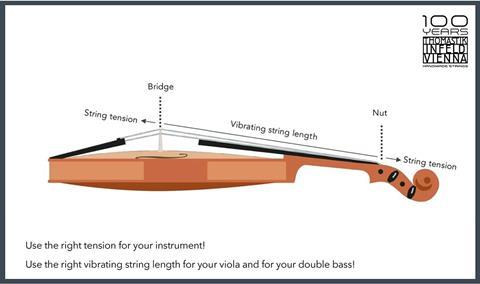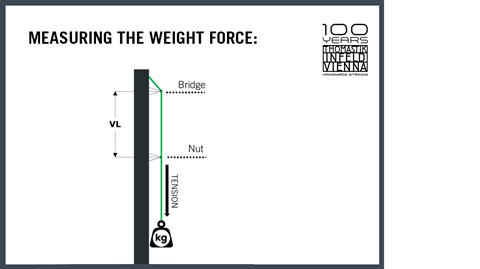These factors can seem a bit too technical or just matter of preference, but it is definitely worth understanding what to look and listen out for

What is vibrating string length?
The ‘vibrating string length’ (VL) of a string instrument is the distance from the inside edge of the bridge to the inside edge of the nut. The vibrating string length must not be confused with the body length. This is important for selecting the right strings and consequently for selecting the right string tension, in order not to over- or underload the instrument’s soundboard, because both the physical shape of the instrument as well as the sound and character of the strings can suffer as a result. Only by choosing a string tension appropriate to the instrument can optimal sound and haptic properties be developed for musician and tool.
- In the case of violins, the vibrating string lengths are between 32.5 cm and 32.8 cm on average.
- For violas, there are no clearly standardised relationships (norms) between body lengths and vibrating string lengths. It is possible to have a small body with a long vibrating string length or a large body with a short vibrating string length. However, on average, vibrating string lengths for violas are between 37 cm and 38 cm.
- Cellos essentially have vibrating strings lengths of around 70 cm. Thomastik-Infeld also indicates the vibrating string lengths for cello strings at 70 cm.
- Compared to violins or cellos, the sizes and proportions are much less standardised for double basses. The current standard size is the 3/4 size, which corresponds to a vibrating string length of 103-106 cm. For a 4/4 double bass, a vibrating string length of 106-110 cm is usual, but there are also instruments outside this range.
What is string tension?
String tension or weight force is the force that must pull on a string in order to generate the desired tone for a specified vibrating string length (VL). This force is essentially calculated and indicated using the physical unit of the Newton. However, for easier comprehension and improved user-friendliness, the Thomastik-Infeld catalog shows string tension or weight force (Newton) converted to a mass equivalent (indicated in kg or lb, 1 kg = 2.20462 lbs).

How do frequency, vibrating string length and string mass affect string tension?
‘Taylor’s Formula’ describes the relationship between the string tension F (weight force) of a string depending on the string mass m, the frequency f (pitch) and the vibrating string length VL. The string tension is quadratic both to the change in frequency as well as the change in vibrating string length. If the string is tuned only a little higher, the string tension and thus the pressure on the instrument’s soundboard increase disproportionately.

The same applies to the change in the vibrating string length. It is therefore very important to select the right vibrating string length for the instrument. The string tension indicated in the Thomastik-Infeld catalog (converted into kg or lb) refers to the respective vibrating string length, which is also shown in the catalog.
Are the indicated vibrating string lengths the same for all string manufacturers? What should be taken into consideration?
The indicated vibrating string lengths often vary between different string manufacturers, which can make it harder to compare them. Take the data for cello strings, for example. Thomastik-Infeld uses a reference value of 70 cm for the vibrating string length of cello strings. For this vibrating string length, the required attached mass of the Alphayue Cello A-string is 17.7 kg (as indicated in the Thomastik-Infeld catalog).
Another string manufacturer indicates a vibrating string length of 69 cm as the reference value for calculating its cello strings. For its indicated vibrating string length, the required attached mass for this A-string is 17.6 kg. At first glance, it would appear that this product requires a smaller mass to tune the string to an A; in other words, this string would seem to have a smaller string tension. However, converted to the vibrating string length of 70 cm, this product needs a mass of approx. 18.1 kg. This means that for the same vibrating string length, the Alphayue Cello A-string has less string tension, namely 17.7 kg.
When selecting the right string, the goal is not only to improve the sound and handling but also to retain or improve the instrument’s good condition. An incorrect string tension can exert both too much and too little pressure on the instrument’s soundboard.
How does string tension affect the sound and instrument?
String tension is an important parameter for an instrument. It defines the force required to tune the strings to the basic tones for a certain vibrating string length. The string tension exerts a certain pressure on the soundboard of the instrument:

In other words, about 42 to 45% of the total string tension applies pressure to the bridge. The instrument’s sound can unfold best when the right string tension is chosen and the pressure on the soundboard and structure of the instrument is thus ideally balanced.
As already mentioned, an incorrect string tension can lead to over- or underload: the latter results only in a loss of sound, while an overload can also cause the instrument to become permanently damaged.
- When strings sound somewhat nasal or very metallic, this can be a sign that the instrument is underloaded, which means there is too little pressure on the soundboard. A string with insufficient tension can also feel harder under the fingers when playing. The many reflections of vibrations on the bridge, which feed back into the string, are the physical reason for this.
- In the case of overload, the instrument reacts immediately, mostly sounding darker and broader. Brilliance and timbre can reduce considerably, causing the instrument to lose the necessary overtones and a portion of the metallic sound component over time. It can then sound hollow and trumpet-like. Overload also reduces the tonal life span of the strings, which continues to shorten each time a new set of strings is mounted onto the instrument with the same string tension. In addition, the strings often also feel softer under the fingers.
In contrast to underloading, overloading can cause long-term damage to the instrument.
There are two different and serious phenomena to consider here:
The soundboard can exhibit orthotropic linear viscoelastic behavior due to the overload. A smaller overload (from light to medium, for example) causes the soundboard to sink, but it can recover again completely and reverse the behavior in the long term.
The more serious case is an overload exhibiting orthotropic non-linear viscoelastic behavior. Here, the instrument is extremely overloaded (from light to heavy, for example) and the soundboard can sink irreversibly. A solution in both cases would be to temporarily underload the instrument – this can last for up to 6 months. So by changing to strings with a lower string tension, the soundboard can recover again and mostly reacquire its shape, allowing the sound to unfold optimally once more.
Initially, this often produces a nasal and brighter sound because, as already mentioned, the instrumented is now underloaded in this setting. However, if the optimal string tension has been selected, this sound phenomenon will pass, the soundboard can reacquire its shape, and the sound can unfold optimally for the long term. This requires patience but persisting with the use of inappropriate and excessively high string tension will continue to damage the instrument’s body.
You would do well to seek the advice of an expert, as each instrument is different, and its rehabilitation can be a long journey.
Article by Thomastik-Infeld’s director of engineering and technology, Franz Klanner











































5 Readers' comments